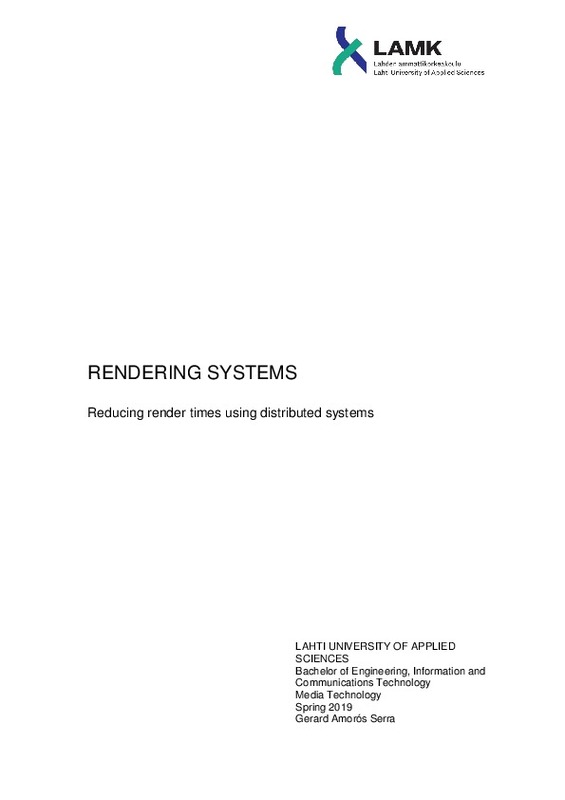JavaScript is disabled for your browser. Some features of this site may not work without it.
Buscar en RiuNet
Listar
Mi cuenta
Estadísticas
Ayuda RiuNet
Admin. UPV
Render systems
Mostrar el registro sencillo del ítem
Ficheros en el ítem
| dc.contributor.advisor | Linares Pellicer, Jordi Joan
|
es_ES |
| dc.contributor.advisor | Koskimaa, Olli
|
es_ES |
| dc.contributor.advisor | Jakonen, Ismo
|
es_ES |
| dc.contributor.author | Amorós Serra, Gerard
|
es_ES |
| dc.date.accessioned | 2020-02-20T09:44:01Z | |
| dc.date.available | 2020-02-20T09:44:01Z | |
| dc.date.created | 2019-05-31 | |
| dc.date.issued | 2020-02-20 | es_ES |
| dc.identifier.uri | http://hdl.handle.net/10251/137364 | |
| dc.description.abstract | [EN] The rendering process is a common bottleneck in businesses like animation studios. There are many ways to get around this problem, among them is a render farm. In this study the factors affecting rendering are examined, from hardware and lighting effects to parallelization costs. To analyze this, a render farm with Autodesk’s Back-burner is set up and multiple benchmarking tests are realized. The purpose of this study is to better understand the render farm as a solution to long render times. Balancing their costs with its benefits and creating models to predict the speedup in real world scenarios. How to set up a render farm and what effectiveness we can expect from it at different scale points. How to avoid bottlenecks and other problems and how to get high efficiencies. We found some guidelines on price points for a targeted speedup and when cloud computing options are better suited for a use case. Specifically, small render farms from one to thirty machines are studied, how the length of rendering times affects the speedup and how higher resolutions impact ren-dering times. The concept of using the manager machine as a rendering machine for increased throughput is put to the test. It is found that long jobs achieve higher speedups and that small render farms can use the manager machine to render at the same time without a noticeable impact on the network. The work focused around the parallelization costs and speedups, explaining what factors limit the speedup and discussing ways to minimize this. Finally, a brief introduction to the environmental impact of a render farm expressed in its carbon footprint is discussed. | es_ES |
| dc.format.extent | 44 | es_ES |
| dc.language | Inglés | es_ES |
| dc.publisher | Universitat Politècnica de València | es_ES |
| dc.rights | Reserva de todos los derechos | es_ES |
| dc.subject | Sistemas de renderizado | es_ES |
| dc.subject | Renderizado | es_ES |
| dc.subject | Render farm | es_ES |
| dc.subject | Benchmarking | es_ES |
| dc.subject | 3DS max | es_ES |
| dc.subject | Backburner | es_ES |
| dc.subject | Autodesk | es_ES |
| dc.subject | Servicios en la nube | es_ES |
| dc.subject | Análisis económico | es_ES |
| dc.subject | Render systems | es_ES |
| dc.subject | Rendering | es_ES |
| dc.subject | Cloud services | es_ES |
| dc.subject | Economic analysis | es_ES |
| dc.subject.classification | LENGUAJES Y SISTEMAS INFORMATICOS | es_ES |
| dc.subject.other | Grado en Ingeniería Informática-Grau en Enginyeria Informàtica | es_ES |
| dc.title | Render systems | es_ES |
| dc.type | Proyecto/Trabajo fin de carrera/grado | es_ES |
| dc.rights.accessRights | Abierto | es_ES |
| dc.contributor.affiliation | Universitat Politècnica de València. Escuela Politécnica Superior de Alcoy - Escola Politècnica Superior d'Alcoi | es_ES |
| dc.contributor.affiliation | Universitat Politècnica de València. Instituto Universitario Valenciano de Investigación en Inteligencia Artificial - Institut Universitari Valencià de Recerca en Intel·ligència Artificial | es_ES |
| dc.contributor.affiliation | Universitat Politècnica de València. Departamento de Sistemas Informáticos y Computación - Departament de Sistemes Informàtics i Computació | es_ES |
| dc.description.bibliographicCitation | Amorós Serra, G. (2019). Render systems. http://hdl.handle.net/10251/137364 | es_ES |
| dc.description.accrualMethod | TFGM | es_ES |
| dc.relation.pasarela | TFGM\121956 | es_ES |
Este ítem aparece en la(s) siguiente(s) colección(ones)
-
EPSA - Trabajos académicos [5826]
Escuela Politécnica Superior de Alcoy






